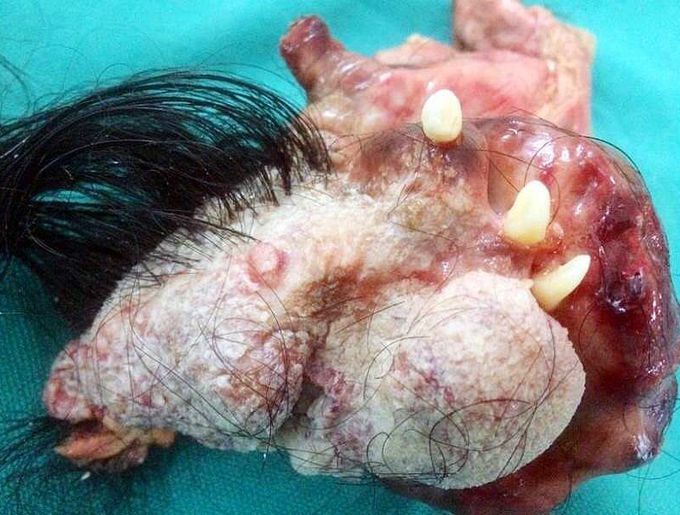


Monster tumor — Hair and teeth found in ovarian tumor!! This is a dermoid cyst, a variant of teratoma
It is a bizarre tumor, usually benign, in the ovary that typically contains a diversity of tissues including hair, teeth, bone, thyroid, epidermis, sebaceous fluid, and all the other goodies of the body. Ovarian dermoid cyst is a slow-growing teratoma that is composed elements from multiple germ cell layers and is of a cystic nature that contains an array of developmentally mature, solid tissues. It may contain substances such as skin, hair follicles, and sweat glands, while other commonly found components include clumps of long hair, pockets of sebum, blood, adipose tissue (fat), bone, nails, teeth, eyes, cartilage, and thyroid tissue. Mature cystic teratomas of the ovary are diagnosed most frequently during the reproductive years, 20-40, commonly incidentally (eg, adnexal fullness) on pelvic examination, during radiographic studies, or during abdominal surgery performed for other indications. Definitive diagnosis is made with seeing an adnexal mass with calcifications on ultrasound and ovarian cystectomy. Because teratomas have variable mass densities, they are prone to ovarian torsion because they have an intrinsically unstable suspension across the infundibulopelvic ligaments, which contain the ovarian vessels. As a result, sudden movement may cause intermittent ovarian vessel occlusion, leading to intermittent ovarian torsion, and severe pelvic pain that worsens with physical activity. Other less common complications such as rupture, infection, malignant degeneration, and hemolytic anemia. The treatment is largely surgical, removed via either laparoscopy or laparotomy. The trick is to excise the cyst without cracking the egg or breaking open its contents.
They can also cause antiNDMA syndrome if they have neural cells.
Hemodynamic stimuli&nonhemodynamic stimuliEffects of sugar on teeth

